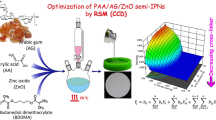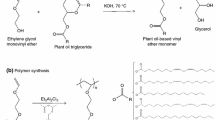Abstract
A new crosslinked, poly(acrylic acid)-based, dehydrating agent was synthesized through solution polymerization. The Taguchi method, a robust experimental design, was adopted to optimize the synthetic conditions based on the moisture and water absorbing capacities of the dehydrating agent. The method applied for the experiment was a standard L27 (38) orthogonal array with eight parameters and three levels. By analyzing the variance of the test results, the most effective parameters to control the moisture absorbing capacity (MAC) and its rate were the kind of alkaline base (LiOH, NaOH, or KOH) used as a neutralizing agent of the acrylic acid monomer and the degree of neutralization: The maximum MAC of 40% was achieved at only 2 h at 32 °C and 50% RH when KOH was used as a base and the degree of neutralization was 90%, respectively. However, the water absorbing capacity (WAC) of the resulting dehydrating agent was very low at 158 g/g, indicating that WAC is unaffected by MAC and its rate in this system. The surface morphologies of the agents were examined using scanning electron microscopy (SEM).
Similar content being viewed by others
References
F. L. Buchholz and A.T. Graham,Modern Superabsorbent Polymer Technology, John Wiley and Sons, New York, 1998.
M. Ende, D. Hariharan, and N. A. Peppas,React. Polym.,25, 127 (1995).
K. M. Raju, M. P. Raju, and Y. M. Mohan,Polym. Int.,52, 768 (2003).
T. Shiga and Y. Hirose,J. Appl. Polym. Sci.,44, 249 (1992).
J. Zhang, L. Wang, and A. Wang,Ind. Eng. Chem. Res.,46, 2497 (2007).
W. J. Zhou, K. J. Yao, and M. J. Kurth,J. Appl. Polym. Sci.,63, 1009 (1997).
Z. S. Liu and G. L. Rempel,J. Appl. Polym. Sci.,64, 1345 (1997).
D. W. Lim, K. G. Song, K. J. Yoon, S. W. Ko, and D.W. Lim,Eur. Polym. J.,38, 579 (2002).
T. Shimomura and T. Namda, Symposium Series 573, ACS, 1994.
A. Li, J. Zhang, and A. Wang,Bioresource Technology,98, 327 (2007).
A. Pourjavadi, M. Ayyari, and M. S. Amini-Fazl,Eur. Polym. J.,44, 1209 (2008).
K. Kabiri, H. Omidian, S. A. Hashemi, and M. J. Zohuriaan-Mehr,Eur. Polym. J.,39, 1341 (2003).
Z. Chen, M. Liu, X. Qi, F. Zhan, and Z. Liu,Electrochimica Acta,52, 1839 (2007).
S. Faust, G. Falk, and D. Y. Lee, US Pat. 7,326,363 (2008).
P. A. Dinnage and G. Tremblay, US Pat. 5,505,769 (1996).
V. C. Srivastava, I. D. Mall, and I. M. Mishra,Ind. Eng. Chem. Res.,46, 5697 (2007).
Minitab Korean R14, Minitab. Inc, 2006.
Author information
Authors and Affiliations
Corresponding author
Rights and permissions
About this article
Cite this article
Kim, JK., Han, YK. Preparation of a crosslinked poly(acrylic acid) based new dehydrating agent by using the taguchi method. Macromol. Res. 16, 734–740 (2008). https://doi.org/10.1007/BF03218588
Received:
Revised:
Accepted:
Issue Date:
DOI: https://doi.org/10.1007/BF03218588




